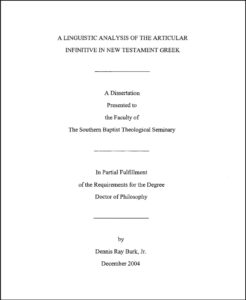Robert Crellin, writer of the entries on prepositions for the Greek Lexicon Project in Cambridge, has recently published The syntax and semantics of the perfect active in literary Koine Greek, (Malden, MA : Wiley-Blackwell), 2016.
The book is not yet available in the Wiley catalogue, but it is projected to cost $45.00. Not bad for a 264 page book by a competent linguist! According to the abstract at the Library of Congress, Crellin
Offers a comprehensive and unified account of the Greek perfect that considers its behaviour in terms of tense and aspect, as well as voice (or diathesis)…
I have not yet been able to get a copy of the book, but according to the abstract, Crellin discusses the syntax and semantics of the Greek perfect using a large corpus of Hellenistic Greek texts that has not previously been discussed in the linguistics literature about the perfect. The book is targeted primarily at linguists and researchers specializing in (Hellenistic) Koine Greek.
Crellin has also recently uploaded his 307 page PhD thesis on the Koine Greek perfect to Academia.edu: The Greek Perfect Active System: 200 BC – AD 150. The thesis was completed in 2012 under the supervision of Geoffrey Horrocks at the University of Cambridge. I’m not certain of the relationship between the book discussed above and the PhD thesis, but here’s what Crellin says of his aim’s and the scope of his corpus in the uploaded thesis:
It is the aim of the present investigation to establish under what circumstances the various senses, past and present, active and medio-passive, may be attributed to the perfect active stem in this period, and from this to seek to provide an account of the semantics and function of the form which most readily accounts for the observed distribution. At the heart of the investigation is a very large corpus, approximately 800,000 words, containing work of the historians Polybius, Plutarch, Josephus and Appian. A combination of close contextual analysis and quantitative statistical methods is then used to analyse this. The investigation is primarily synchronic, but seeks to use findings made on a synchronic level to inform discussion of diachronic developments (p. 3).
I’ve added both the book and the thesis to the bibliography here at Greek-Language.com.

 I have added Dennis Ray Burk’s doctoral dissertation “A linguistic analysis of the articular infinitive in New Testament Greek” to the
I have added Dennis Ray Burk’s doctoral dissertation “A linguistic analysis of the articular infinitive in New Testament Greek” to the 


 Six articles from the recent Gorgias Press release of
Six articles from the recent Gorgias Press release of 
 Brill is publishing a revised version of Francis G.H. Pang’s doctoral dissertation, Revisiting Aspect and Aktionsart: a corpus approach to Koine Greek event typology. Pang completed the dissertation at McMaster Divinity College in May of 2014.
Brill is publishing a revised version of Francis G.H. Pang’s doctoral dissertation, Revisiting Aspect and Aktionsart: a corpus approach to Koine Greek event typology. Pang completed the dissertation at McMaster Divinity College in May of 2014. I have just added Margaret Sim’s 2011 book,
I have just added Margaret Sim’s 2011 book,